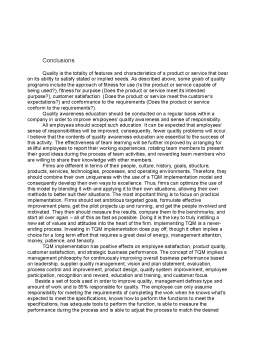Extras din referat
Quality in a World of Globalization
Without question, product quality is needed now as never before. Poor quality, especially in a world of globalization, equates to costs of nonconformance in the area of billions of dollars and, most importantly, oftentimes costs human life.
In accordance to the quality vocabulary stated in ISO8402, quality is defined as
“The totality of features and characteristics of a (product or) service that bears upon its ability to satisfy stated or implied needs.” The 20 century will be remembered as the Century of Productivity, whereas the 21 century will come to be known as the Century of Quality. So predicts Dr. Joseph M. Juran, father of the quality movement (Joseph A. DeFeo, "The Future Impact of Quality" Quality Engineering, Marcel Dekker, Volume 13, Number 3, 2001)
Quality Concept
- Zero Defects
– Implies that there is no tolerance for errors within the system.
– The goal of all processes is to avoid defects in the product or service.
– Similar to six sigma: almost zero defects
- The Customer is the Next Person in the Process
– The internal organization has a system that ensures the product or service is transferred to the next person in the process in a complete and correct manner.
– The product or service being built is transferred to another internal party only after it meets all the specifications and all actions at the current work station.
– Avoids incorrectly assembled components and poor workmanship.
- Do the Right Thing Right the First Time (DTRTRTFT)
– Implies that it is easier and less costly to do the work right the first time than it is to do it the second time.
– Entails the training of personnel to ensure sufficient skills and tools to correctly complete the work.
- Continuous Improvement Process (CIP)
– A concept which recognizes that the world is constantly changing and any process that is satisfactory today may well be unsatisfactory tomorrow.
– A sustained, gradual change to improve the situation.
– Differs from innovation -- does not make a sudden jump to a plateau where it matures over time.
– Focuses on 11 principles: constancy of purpose, commitment to quality, customer focus and involvement, process orientation, continuous improvement, system-centered management, investment in knowledge, teamwork, and conservation of human resources, total involvement, and perpetual commitment.
– Rather than manage the output of the project, the focus is on managing the total process and subprocesses. The process is held constant only after it has been proven capable of the work. Hence, the product naturally meets the requirements.
– CIP steps:
- Define and standardize processes (and subprocesses).
- Assess process performance.
- Improve processes and measure progress.
Overall Business Performance
Employee Satisfaction
The firm should regularly evaluate its employee satisfaction level in order to seek the solution to improving employee satisfaction, commitment, and motivation. There are two ways to measure employee satisfaction. One is to obtain direct information from the employees. Thus, the firm should develop a measurement instrument that can be used for obtaining employee satisfaction information directly. In order to obtain relatively accurate information, employees should be asked to fill in survey questionnaires anonymously. The alternative way of assessing employee satisfaction can be conducted by a group of people from the top management team and different functional departments within the firm. These people can assess employee satisfaction according to their perceptions. These two methods of assessing employee satisfaction are based on a set of facets that may affect employee satisfaction in the firm. Through obtaining employee satisfaction data, areas with which employees are not satisfied can be identified. Such information can be used to improve the firm’s TQM implementation efforts. Also, employee satisfaction information can be used to study the time dimension of TQM implementation. Many facets may affect employee satisfaction; they are listed as follows:
- Annual income (e.g., salary, bonus);
- Equity, fairness, and equal opportunities;
- Recognition and reward schemes;
- Job security;
- Democratic management (e.g., involvement in setting the firm’s policies, strategies, and plans);
- Leadership style and ability;
- Top managers’ and supervisors’ conduct;
- Relationships with top managers and supervisors;
- Relationships with coworkers;
- Promotion opportunities;
- Nature of jobs (e.g., work loads, job content);
- Career development (e.g., training, retraining, and target setting);
- Working conditions (e.g., safety, noise, and pollution).
Preview document
Conținut arhivă zip
- Advanced Production Management Systems - Quality Management.doc






















